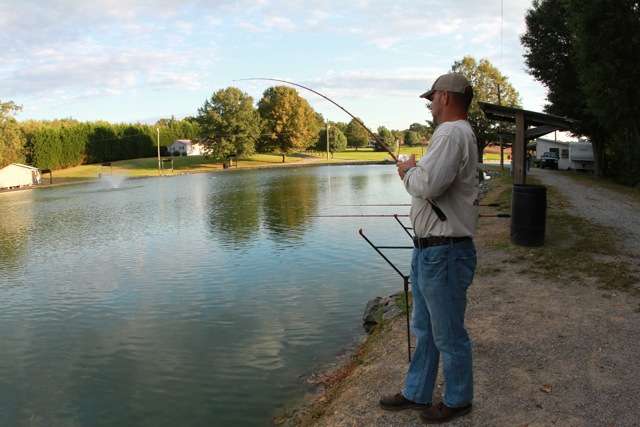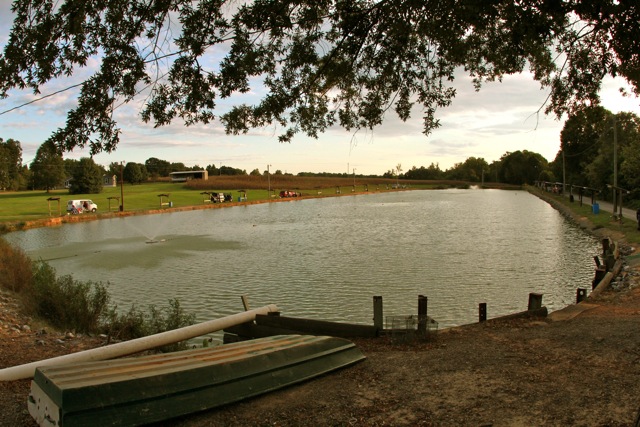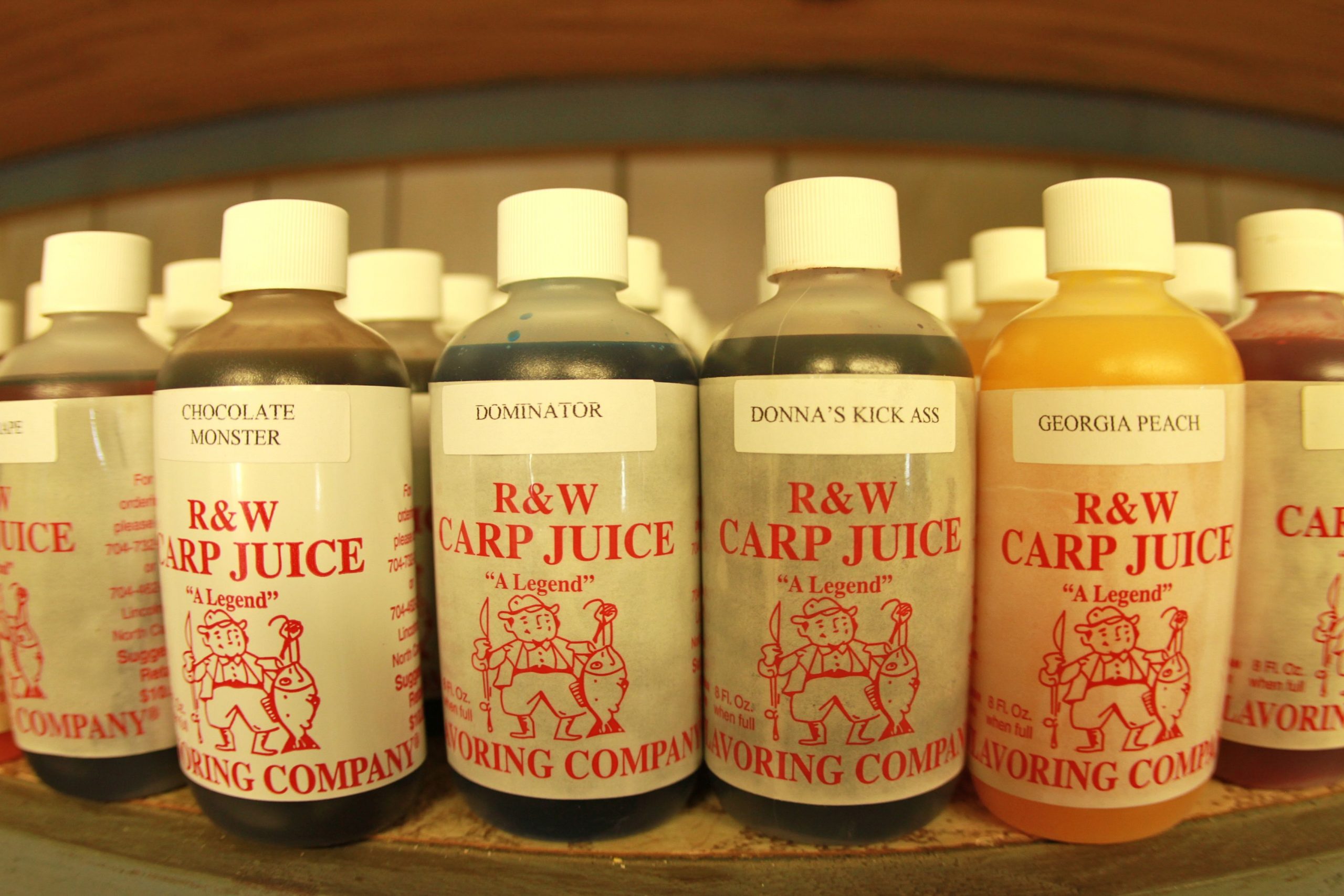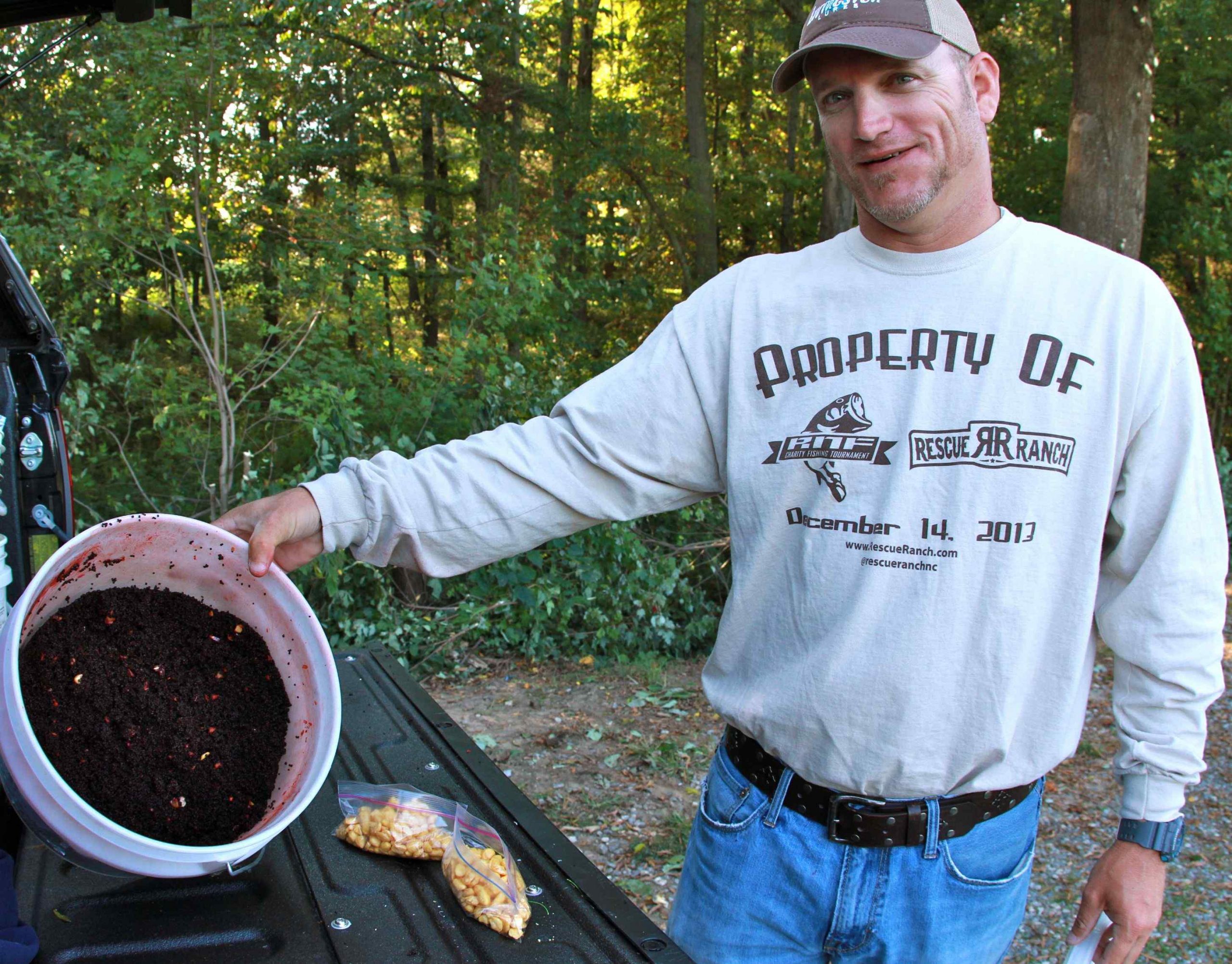
STATESVILLE, N.C. — It sounds strange coming from the 2013 Bassmaster Elite Series Rookie of the Year, but Hank Cherry enjoys catching carp more than any other fish species, as long as the carp are swimming in a “pay lake” in his home state of North Carolina.
“I like it better than bass fishing,” said Cherry, while setting up four rod stands on the bank at Pop’s Lake on a late-October afternoon. “There’s a lot less headaches. It’s such a change of pace from what I’m usually doing.
“Plus, it’s just fun. It reminds you of what you used to do when you were a kid.”
Before making the 35-mile drive to Pop’s Lake, Cherry had picked up two of his Maiden, N.C., buddies, Brandon Dishman and Josh Cook. They have made this journey together many times over the years.
“For a lot of the guys I grew up with, this is the only time I get to see them,” said Cherry, who turned 40 in February.
But this isn’t just about catching fish and hanging out with old pals. It’s also about paying bills. Pop’s Lake is one of hundreds of small pay-to-fish lakes in North and South Carolina. There’s a culture surrounding pay lake carp fishing in the Carolinas unlike anywhere else in the U.S.
“Back in ’08, when the economy got so bad, I was unloading trucks at a feed store,” Cherry said. “I paid most of my bills with winnings from carp fishing.”
There are small privates lakes scattered throughout the country where you must pay a fee in order to fish. Some are associated with trophy bass fishing. Others specialize in trout or catfish. But in the Carolinas, the vast majority features the common carp and a tournament format.
The winnings at carp pay lakes rarely get past four figures. The entry fee at Pop’s on this evening was $85. But weekend events in the summer might require a $400 entry fee. There are “porch pots” set up among the anglers that will award money for the biggest carp caught each hour. Plus there’s often a Powerball element at carp pay lakes in the form of what’s called “the floating jug.”
On this night, to win the floating jug jackpot you had to catch a carp weighing exactly 28 pounds, 2 ounces. It’s a random weight that’s drawn before each tournament. If no one wins, the jackpot builds until someone does.
Cherry said his best night at a pay lake put $3,700 in his pocket through hourly and overall jackpots. He has heard about a floating jug that paid $13,000.
Here’s the kicker: There are so many pay lakes in this area that for nine months of the year you can fish two carp tournaments in a 24-hour period, if you so desire. One lake might hold its event from 9 a.m. until 4 p.m. Another might start at 6 p.m. and end at midnight. The entry fees and rules vary from lake to lake. Most lakes are open five or six days a week in the warm months.
“I’ve heard there are 98 pay lakes within a 100-mile radius of Hickory, North Carolina,” said one of the anglers gathered at Pop’s. “I’m 73 years old, and I started going to pay lakes in my late teens in Hickory.”
In the Internet age it’s astounding that something so popular and so common in the Carolinas can remain so foreign to almost everyone outside the two states. There are pockets of carp pay lakes in the upper Midwest, and Pennsylvania has a few. But you can mention carp pay lakes to an angler in nearby Alabama or Georgia and most likely he won’t have any idea what you’re talking about.

“Welcome to redneck paradise,” Cherry said as he drove his Livingston Lures-wrapped pickup truck on the gravel road leading to Pop’s Lake. The “lake” is actually two three-acre spring-fed ponds. Joe “Pop” Gantt started this business on his farm in 1984. (There are carp pay lakes in this area that date back to the 1940s.)
After Gantt passed away, the family began leasing Pop’s Lake. Chris Southern signed a five-year lease to operate Pop’s Lake early this year.
“I’m 36 years old, and I’ve been fishing carp pay lakes since I was 12,” said Southern. “When Mom or Dad couldn’t take me, I’d find a way to get there. Most of the time I’d ride my bicycle. It might take an hour, if the lake was 10 or 12 miles from our house.”
Southern has been hosting tournaments five nights a week at Pop’s since early spring — from 6 p.m. until midnight. His only nights off are Tuesday and Sunday. In mid-November, he’ll switch to a four days a week – Wednesday, Friday, Saturday and Sunday – from 9 a.m. until 5 p.m. It takes some seriously brutal winter weather to force a carp tournament cancellation.
“We broke ice to fish in the early part of the year,” Southern said.
When you walk in the office at Pop’s, if you’re expecting a typical bait shop, you will be shocked. One set of shelves contains what appears to be breakfast food: grits, pancake syrup, oats and cereal, specifically Kellogg’s Corn Pops (formerly named “Sugar Pops” before sugar became a four-letter word) and Arrowhead Mills’ Puffed Corn Cereal. For some anglers, those breakfast cereals are key ingredients for catching carp.
But there are seemingly endless varieties of key ingredients for catching carp. It’s a highly personalized choice.
“Some of the guys who fish here buy their flavorings at another lake because they don’t want anyone to know what they’re using,” Southern said. 
“Flavorings” – that’s what fills the plastic bottles that occupy the largest amount of shelf space in Pop’s. It’s the craziest list of liquid carp attractants that anyone could imagine, everything from the common (vanilla, chocolate, strawberry, hazelnut) to the bizarre (Godzilla, Spiderman, Donna’s Kick Ass, Dominator, Green Monster). Most of these flavorings are made by R&W Carp Juice, located in Lincolnton, N.C.
“I’ve heard there are something like 750 or 760 flavors,” Cherry said.
And these are just ingredients – ingredients for a recipe to catch carp – carp that have increasingly sophisticated taste buds after being caught again and again and again. Carp lakes are strictly catch-and-release.
“The old carp fishermen say, ‘Whatever’s growing, that’s what you’re throwing,'” Cherry proclaims.
Because it’s late October, pumpkins are on the rise, so pumpkin spice might be a key ingredient on this night. In the spring, the old-timers choose something in a nice strawberry or peach flavor.
But flavorings are just one ingredient in a “pack bait,” which is a fist-full of cereal, liquid flavorings and maybe canned corn – creamed style or whole kernel – that’s hand-squeezed around a hook. To quote Dave Barry, “I‘m not making this up.”
“Some guys have recipes that are measured exactly and have been handed down from generation to generation,” Cherry said.

Cherry isn’t so exacting. He breaks open a two-pound bag of black “chow,” used for feeding hatchery raised fish, and dumps it in a plastic two-gallon bucket. He adds a can of cream style corn, squeezes in some liquid flavorings and hand blends it all together. Cherry does this about 30 minutes before our 6 p.m. start time, so the mixture has time to get “ripe.” And ripen it does.
“Concord grape and butternut are a couple of standard flavors,” he said. “They work anywhere.”
Before the competition begins, Chris Southern gathers everyone outside the shop in front of a hand-painted map of the two carp ponds at Pop’s. In a country version of the NBA draft lottery, numbers are drawn from a purple Crown Royal bag to decide the order for choosing the various “pegs” on the ponds — the section of the bank where you will fish for the evening.
It’s a Monday, it’s getting well into cooler fall weather and many local folks are shifting their focus to deer season. The usual throng of Pop’s Lake regulars has thinned. There are only about 15 pegs chosen from the 47 available around the two ponds. Cherry draws an early number and takes peg No. 7. Dishman and Cook take an adjacent peg.
Then we drive the short distance to our pegs on the upper pond and begin setting up. It’s a good thing that a boat isn’t required in pay lake carp fishing. It’s expensive enough to purchase all the specialized fishing tackle needed to make money at this carp fishing game.
Some pay-lakers use a small electronic device that attaches to each rod. It signals that a carp is nibbling at your bait.
“The money spent on carp fishing in North Carolina and South Carolina is unbelievable,” Cherry said.
I believe him.
Each angler is allowed four rods, which are placed in rebar rod holders – another specialized item – that you stick within the boundaries of your peg on the pond bank.
Cherry feels good about our prospects as the 6 o’clock start time approaches.
“The later it gets, the better this pond gets,” he said. “It’s just the personalities of these two ponds.”
There are mercury vapor lights on telephone poles surrounding the ponds. Each peg has a tin roof-covered bench, which serves as a baiting station. Southern announces over the loudspeaker system when the competition officially begins. At 6:05 Southern broadcasts the news that a 15-pound, 14-ounce carp has been weighed-in. It’s quickly topped by a 22-5. When Cherry lands a carp at 6:15 that looks to be in the 16- or 17-pound range, he doesn’t bother taking it to the scales.
After darkness had settled over Pop’s Lake, we were joined by Erick Arnoldson and Ricky Espinoza, who work for Livingston Lures, one of Cherry’s main sponsors on the Elite Series tour. Livingston is also one of the main sponsors on the B.A.S.S. tournament trail. I soon learned the value of sponsors, as Arnoldson and Espinoza hauled a big cooler and four sacks of fast food sandwiches and fries to our pegs at Pop’s.
When there’s a bigger crowd at Pop’s, Southern hires a cook, who grills hamburgers and hot dogs outside the office.
Just as Cherry predicted, the later it got, the better the carp bit at our spots on the upper pond. The 10 o’clock hour was our peak. We took turns reeling in 10 carp during those 60 minutes, the biggest being a 20-10 that Espinoza landed. But a 21-13 won the big fish pot for the hour.
It only takes one session on a carp pay lake to understand how addicting this can be.
First of all, it’s fun to catch a line-stretching, bulldogging fish like a carp, especially when it weighs 15 to 20 pounds. I kept a precise count; we landed 29 carp during the six-hour tournament, and 19 weighed between 15 and 20 pounds. The smallest carp weighed about 8 pounds.
Secondly, the hourly opportunity to win some cash puts an added thrill in every fish fight. We were in the ballpark of first place almost every hour. In addition to Espinoza’s 20-10 getting topped by a 21-13, Dishman weighed a 19-13 in the hour when a 20-0 took top honors, and Cook landed an 18-0 in the final hour when a 19-6 won. A 24-10 won first place overall that night.
There are some much bigger carp in Pop’s Lake.
“We’ve had three this year that were over 42 pounds,” Southern said.
Finally, although we had an all adult male group, don’t get the idea that’s necessarily the norm.
“When we first starting going out, we had lots of carp fishing dates,” said Jaclyn Cherry, Hank’s wife, during a recent conversation.
Their four-year-old son, Christian is hooked too, according to Hank, and he’s not yet old enough to understand the cash incentive.
“It’s huge in the summer,” Cherry said. “On Fourth of July week, all these pay lakes have something special every night. Some people spend their entire family vacations to come carp fishing.”
Big fish, big bucks and big fun — what’s not to like about an outing at a carp fishing pay lake?
For more photos from Pop’s Lake, click here.
